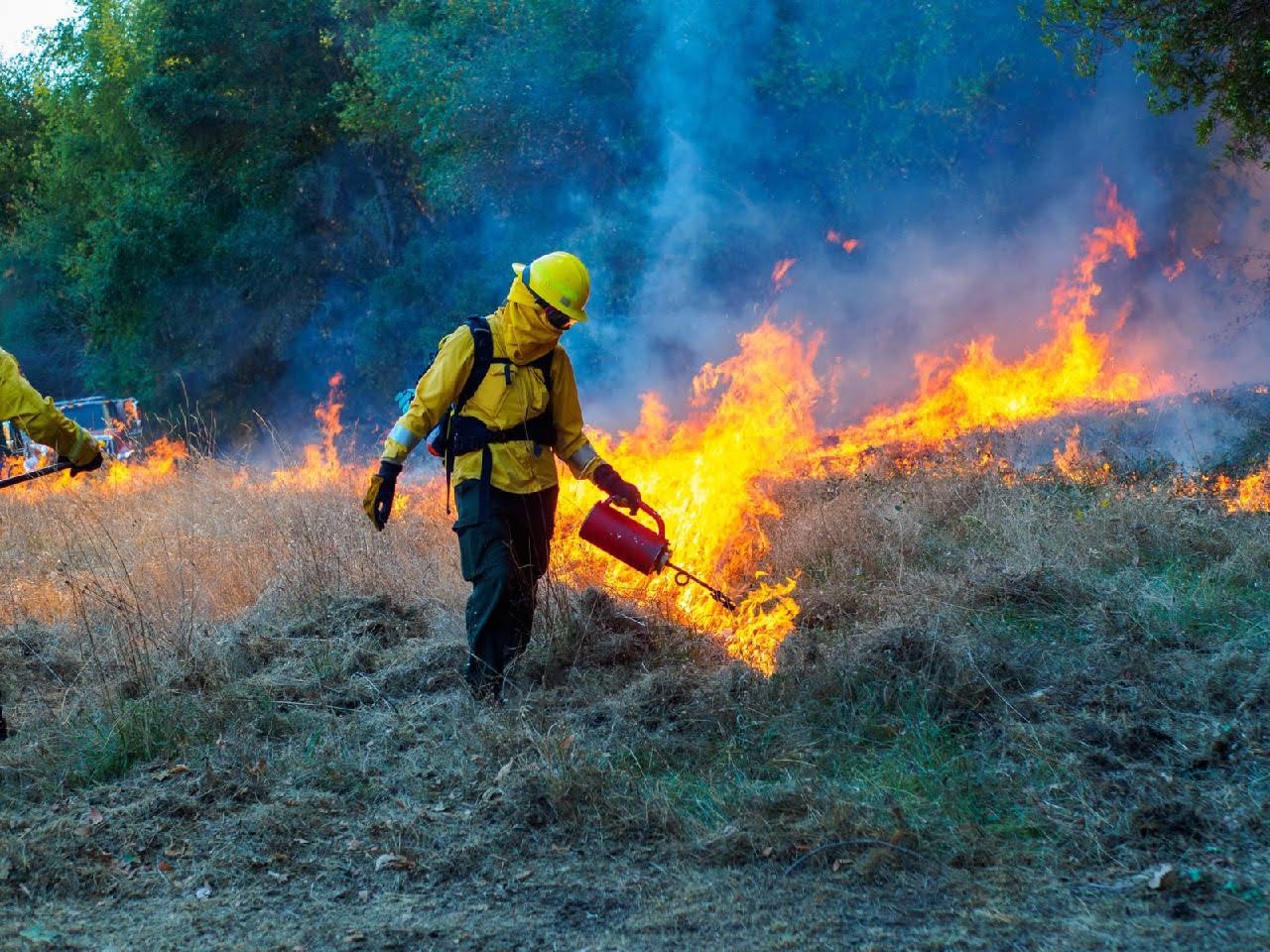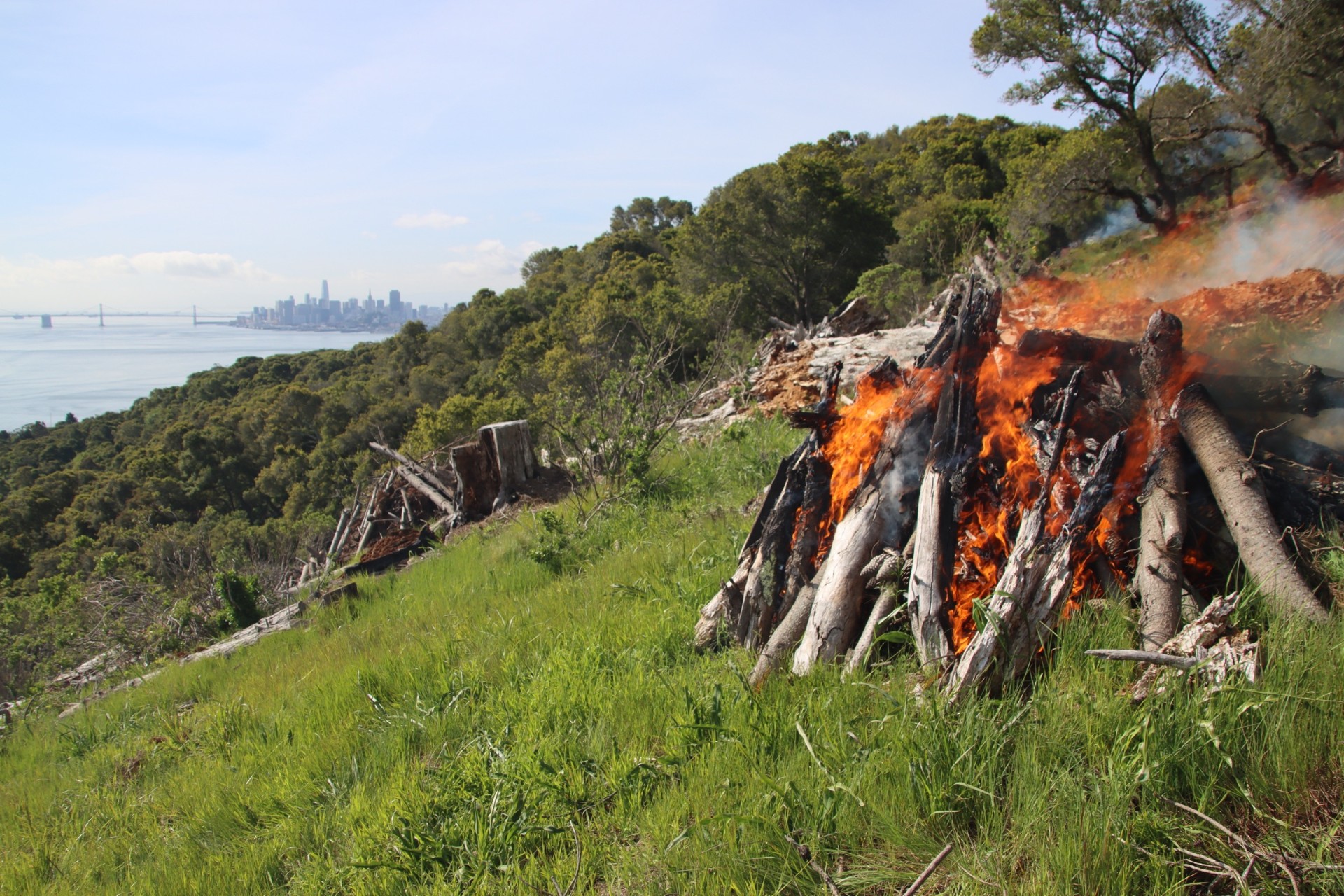Frequently Asked Questions
Why is it called "prescribed" fire?
The word "prescribed" is used to describe fires that are lit intentionally within our local State Parks because they are ignited under a specific set of environmental conditions that collectively constitute a prescription. These conditions typically include temperature, wind speed and direction, fuel moisture, and relative humidity, but seasonality and other factors may be included. The prescription is developed to meet specific goals and objectives that are developed by State Park staff and partners who possess deep knowledge of fire behavior and local ecology. It must be followed to safely and effectively conduct the prescribed fire operation, which may sometimes be referred to as a prescribed burn or a controlled burn. The prescription will also specify whether the fire will be contained to piles of dead vegetation (pile burning) or if it will intentionally spread through a specified area (broadcast burning). There are other types of beneficial fire, sometimes referred to as “good” fire beyond prescribed fire, including cultural burning and managed wildfires. The California Wildfire and Forest Resilience Taskforce provides more in depth information about beneficial fire across the state.

An image from a prescribed pile burn in Bothe-Napa Valley State Park in 2023.
 An image from a prescribed broadcast burn in Jack London State Historic Park in 2022.
An image from a prescribed broadcast burn in Jack London State Historic Park in 2022.
Why does State Parks conduct prescribed fire?
Human and lightening ignited fires have played a key role in defining California’s landscapes for many millennia. Many plants and animals are well adapted to, and sometimes depend on fire to move through their life cycles. California has a Mediterranean climate. That means that we have relatively warm, dry summers and cool, wet winters. Plants grow during the winter and spring and then act as potential fuel for fires in the summer. This plant material does not decompose very quickly in many of the ecosystems in the Bay Area District’s State Parks and over time accumulates due to California's dry summers. Without fire to recycle this built up dead plant material, it accumulates and can cause more intense fires when it does burn. This can pose heightened risks to people as well as plants and wildlife that have evolved with and are adapted to less intense fires. As Californians, we don’t get to choose whether our landscapes burn, but we can influence when and how fire moves through the landscape in some situations.
What are the benefits of prescribed fire?
Almost all of California’s landscapes have evolved with fire, so fire is an integral part of stewarding them. Prescribed fires return nutrients to the soil, stimulate plant growth and germination, and help sustain the complex mosaic of plant communities that support California's tremendous biodiversity. Prescribed fires can also remove fuel from the landscape making it safer for people and helping State Parks conduct targeted stewardship of vegetation, including the management of invasive species.
What factors does State Parks consider when planning a prescribed fire?
Safety is always the first consideration. There are many places that could benefit from prescribed fire that, for a variety of reasons, are not appropriate for prescribed fire. Where fire can safely be applied, its effect on the plant and animal communities is the next consideration. After that, details of when and how to apply fire to the area to achieve the desired result are considered.
How long does a prescribed fire typically last?
This depends primarily on the vegetation that is being burned, the size of the prescribed fire, and how well the smoke disperses. Prescribed fires in grasslands of up to several hundred acres can sometimes be safely conducted in a single day with very little residual fire or smoke. Broadcast burning in forests typically takes much longer, due to the larger fuels that can burn for multiple days after being ignited. The portion of the burn where a fire is actively being lit may take as much as multiple days and the area that has been lit may smolder for weeks following ignition and only be completely extinguished when it rains. Prescribed pile burns can be completed over the course of a day, or longer depending on the type and size of material in the piles.
How does State Parks ensure the safety of people and adjacent properties during a prescribed fire?
Prescribed fires are carefully planned by staff with extensive training and experience. Prescribed fire plans (sometimes called burn plans) are reviewed by CAL FIRE, the State’s fire suppression agency or at times local fire agencies with jurisdiction, such as the Marin County Fire Department, who also permit burning throughout much of the year. Most prescribed fires in Bay Area District Parks are generally supported and/or led by staff from one of these fire agencies. Burn plans list the set of environmental conditions under which the fire can be lit (the prescription), and what resources must be available (fire fighters, fire engines, helicopters, etc.) either on site or in contingency prior to ignition. Prescribed fires generally start with a small test burn to determine how smoke will disperse and whether it is safe to burn, at which point a decision about proceeding will be made only if it safe to do so. A prescribed fire can be cancelled at any time prior to or after its ignition if these factors or other safety concerns warrant the cancellation of a burn. If the burn has already started, this may require the suppression of the fire which can take time, especially in forested areas.
How does State Parks ensure minimal impact on air quality when burning?
State Park staff work closely with our local air districts who model and forecast expected smoke dispersal and adjust our plans to limit smoke production when it is likely to have negative impacts on the community. The Bay Area District's State Parks all fall under the jurisdiction of the Bay Area Air Quality Management District.
What happens to the animals in the area of the prescribed fire?
Most animals are adapted to fire. They either leave the area or seek refuge underground or in moist places that are unlikely to burn. While the vast majority of animals are unharmed, some are adversely impacted by prescribed fires, but many fewer than in fast-moving wildfires. Most prescribed burning in the Bay Area District’s State Parks happens seasonally to avoid periods of nesting when many local animals may be raising young and might be unable to leave a burning area.
How can I tell if a fire is a prescribed fire or a wildfire?
Prior to igniting a prescribed fire, California State Parks makes every effort to inform the community. This includes updates to our park websites and social media accounts, the posting of signage in the parks as well as the dispersals of press releases to local media outlets. If you see smoke or fire coming from a state park and are not sure, you can look to these places as well as websites and social media accounts connected to CAL FIRE's Sonoma-Lake-Napa Unit and local fire departments. Wildfire alerts and evacuation updates will also be shared by Sonoma County, Marin County and Napa County through thier local emergency alert systems. There are a number of websites (also available as smartphone apps), such as Watch Duty and PulsePoint, that will alert you about wildfires and may also provide information about prescribed fires.
Where can I find out about prescribed fire in advance?
For prescribed burns conducted in state parks in the Bay Area District’s State Parks, check this website and feel free to reach out to contact information below with questions. Announcements and updates are also made on social media pages and individual park websites when a burn is planned or has recently occurred in a State Park. We also recommend following CAL FIRE's Sonoma-Lake-Napa Unit and the Marin County Fire Department on social media for updates on their agency's prescribed burns and wildfire response in our area.
Who can I talk to if I have more questions about prescribed burns?
Call the Bay Area District Office (707) 769-5652 or email BayAreaNaturalResources@parks.ca.gov. A phone number and email for public information contact(s) will be provided on signage and in press releases and website updates for any given prescribed fire.

